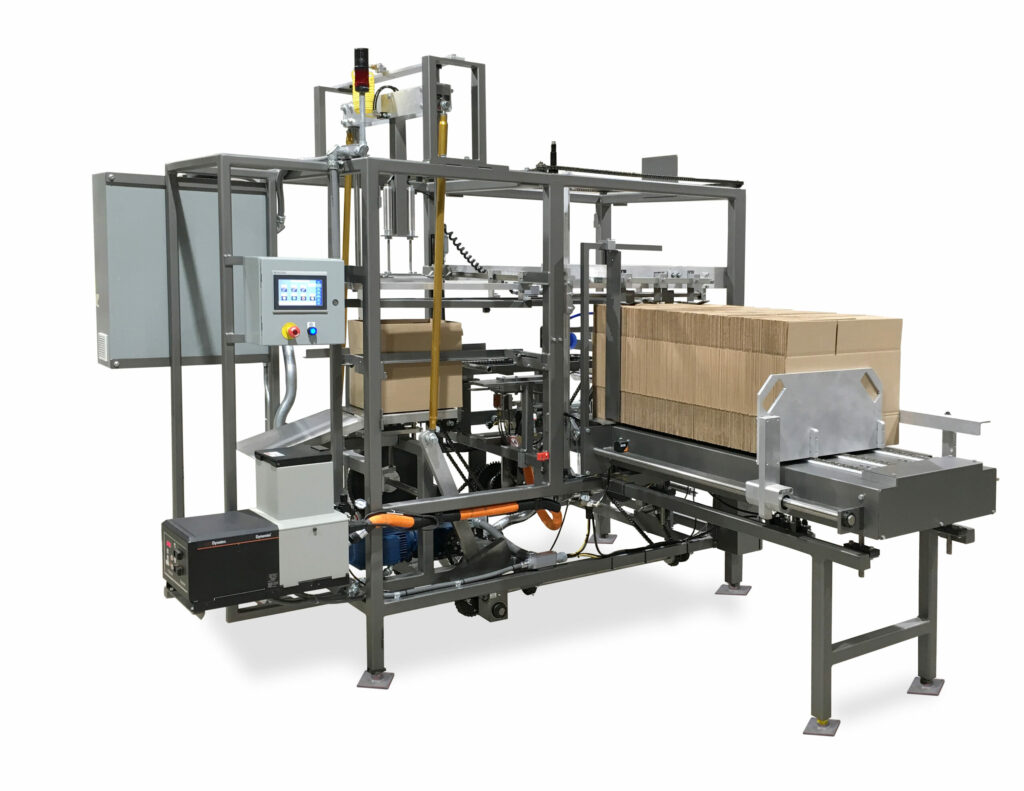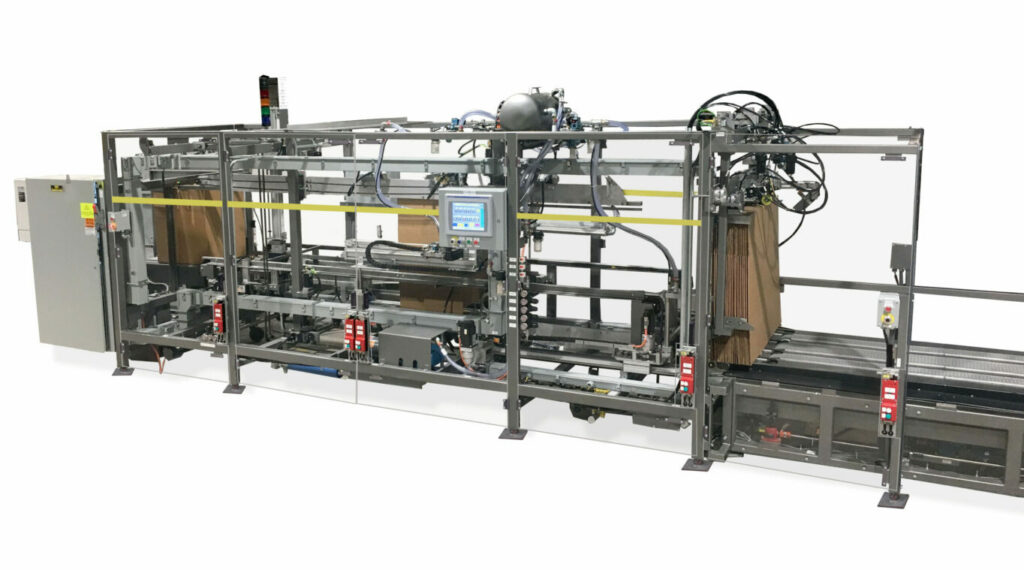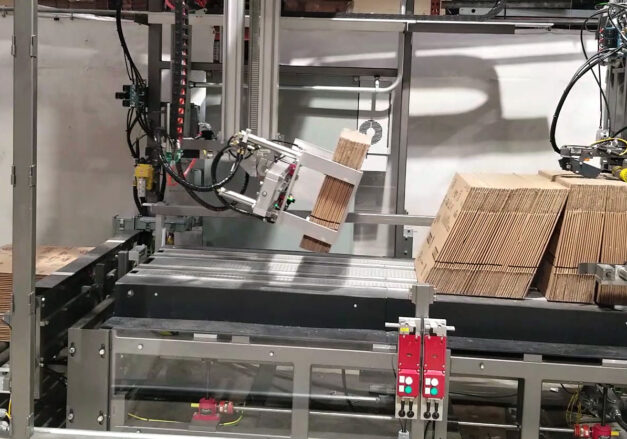Multiple layers of packaging are necessary to deliver a finished product from the manufacturing floor to the customer’s door. Often these layers are sectioned into primary, secondary, and tertiary packaging. Secondary packaging refers to the layer surrounding the primary package to safeguard products during shipment, storage, and handling.
“Secondary packaging is the material used to protect finished goods from the manufacturer during transit to end users. Think corrugated shipping cases and internal partitions used to block and brace.”
Ben Goodman – Wayne Automation Southeast and Western Regional Sales Manager
Secondary Packaging Examples
The main function of secondary packaging is to prevent damage or breakage of the product during shipping and handling. It can also provide additional information about the product, such as a barcode, expiration date, and other important labeling.
 Secondary packaging can take many forms, including cardboard boxes, cartons, crates,
Secondary packaging can take many forms, including cardboard boxes, cartons, crates,
blister packs, shrink wrap, and more, depending on the product and its specific packaging requirements.
Overall, secondary packaging is a critical component of the supply chain as it ensures the safe transit of products to their intended destination.
It is an essential consideration for manufacturers, distributors, and retailers who want to maintain high levels of customer satisfaction and protect their brand reputation.
The Purpose of Secondary Packaging
Maintaining the safety and quality of products while they are being transported and stored is often seen as the main purpose of secondary packaging. This type of packaging is used in all major industries, but especially:
- Glass and Plastic Industries Secondary packaging is commonly used to transport fragile products, such as bottles and containers, ensuring they are safe from damage and breakage. Similarly, in the beverage industry, secondary packaging like cardboard boxes and banding material offer added protection during transportation. They also help ensure product units remain intact in retail displays.
- Petrochemical Industries Secondary packaging provides additional security for hazardous materials. For instance, plastic drums or containers used for transporting chemicals must be filled, covered, and packaged appropriately with good secondary packaging to ensure safe handling.
- Food Industries Secondary packaging is essential for maintaining product freshness and appearance. The packaging prevents contamination, preserves food quality, and extends shelf life. Examples of secondary packaging commonly used in the food industry include corrugated cardboard boxes and trays.
Secondary Packaging Components
While primary packaging protects the product’s contents, secondary packaging protects the product units and facilitates the delivery process.
 Some common components of secondary packaging include:
Some common components of secondary packaging include:
- Cardboard Cartons
- Chipboard Cartons
- Cardboard Boxes
- Cardboard/Plastic Crates
- Paperboard Cartons
- Trays
Although product protection is perhaps the top job of secondary packaging, it also plays a crucial role in maintaining customer satisfaction, especially when shipping fragile or luxury products.
Selecting the right type of packaging for a product can impact the product’s safety during shipping, the packaging process, and private branding.
Benefits of Automating Your Secondary Packaging Process
“We see customers turning towards automation for consistent, standardized packaging set ups, processed at rates higher than what is possible through individual handling.”
Ben Goodman – Wayne Automation Southeast and Western Regional Sales Manager
Automating the packaging process can offer several benefits to a company, including:
Increased Efficiency: Automation can improve the speed and accuracy of the packaging process, reducing the likelihood of errors and delays. This delivers increased productivity and faster turnaround times for orders.
- Increased Efficiency: Automation can improve the speed and accuracy of the packaging process, reducing the likelihood of errors and delays. This delivers increased productivity and faster turnaround times for orders.
- Cost Savings: By automating the secondary packaging process, a company can reduce labor costs, minimize waste, and optimize the use of materials. This can provide significant cost savings over time.
- Better Quality Control: Automation can provide greater visibility and control over the packaging process, allowing for better quality assurance and compliance with industry regulations. This ensures that products are packaged correctly and meet the required standards, improving customer satisfaction and reducing the risk of product recalls.
By automating your secondary packaging process, you can provide these and other significant benefits to your company and your customers.
How Wayne Can Help Automate Your Secondary Packaging Process
Wayne Automation is a leading provider of custom automated secondary packaging solutions for companies looking to optimize their supply chain operations. With years of experience in the industry, Wayne Automation is uniquely positioned to design and implement packaging solutions that meet the specific needs of each client.
 Our company offers a range of automated secondary packaging equipment and services designed to improve efficiency, reduce costs, and ensure compliance with industry regulations.
Our company offers a range of automated secondary packaging equipment and services designed to improve efficiency, reduce costs, and ensure compliance with industry regulations.
These solutions include everything from automatic case erectors and tray formers to case sealers, packers, and partition inserters.
Wayne Automation works closely with each client to assess their needs and develop a customized packaging solution that meets their unique requirements.
Our company also provides ongoing support and maintenance services to ensure that its packaging solutions continue to operate smoothly and efficiently over time.
A Real-World Example of Shifting from Manual to Automated Packaging with Wayne
 Lifestyle retailer DTLR VILLA had a problem. Each day, employees would assemble all boxes for shipment by hand.
Lifestyle retailer DTLR VILLA had a problem. Each day, employees would assemble all boxes for shipment by hand.
However, with more and more new orders coming in constantly, they were not able to work fast enough to keep up with demand.
See how we helped them transition away from a slow manual packaging system and into a smoothly operating automated packaging system.
What Do You Need Help With?
At Wayne Automation, we want to help you achieve the highest level of efficiency throughout your entire end-of-line process. Of course, the first step in creating an effective automated system is selecting the right machines for the job.
Regardless of what industrial packaging solution you may need, we welcome you to browse through our wide range of automated packaging machines and see how we can help you achieve your goals. Then give us a call.
If you’re still unsure how to reduce packaging costs with automation, we will gladly take the time to answer your questions, arrange a plant tour, or set up a product demonstration so you can make the right decision for your company.
Contact us today and talk with one of our experts.





